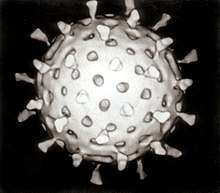Viral envelope
A viral envelope is the outermost layer of many types of viruses.[1] It protects the genetic material in their life-cycle when traveling between host cells. Not all viruses have envelopes.

The envelopes are typically derived from portions of the host cell membranes (phospholipids and proteins), but include some viral glycoproteins. They may help viruses avoid the host immune system. Glycoproteins on the surface of the envelope serve to identify and bind to receptor sites on the host's membrane. The viral envelope then fuses with the host's membrane, allowing the capsid and viral genome to enter and infect the host.
Some enveloped viruses also have a capsid, another protein layer, between the envelope and the genome.[1]
The cell from which a virus buds often dies or is weakened, and sheds more viral particles for an extended period. The lipid bilayer envelope of these viruses is relatively sensitive to desiccation, heat, and detergents, therefore these viruses are easier to sterilize than non-enveloped viruses, have limited survival outside host environments, and typically must transfer directly from host to host. Enveloped viruses possess great adaptability and can change in a short time in order to evade the immune system. Enveloped viruses can cause persistent infections.
Examples of enveloped viruses
Several classes of enveloped viruses that contain human pathogens are recognized.
- DNA viruses
- RNA viruses
- Retroviruses
Nonenveloped viruses
The following classes of nonenveloped viruses that contain human pathogens are recognized:
- DNA viruses
- RNA viruses
See also
References
- "CHAPTER #11: VIRUSES". Archived from the original on 2008-11-10. Retrieved 2008-11-07.
- "The Rabies Virus". CDC. Archived from the original on 2017-01-18. Retrieved 2008-11-07.
External links
- "Virus Structure". Molecular Expressions: Images from the Microscope. Retrieved 2007-06-27.
